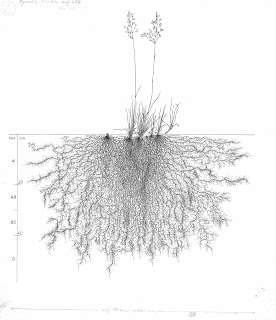Remarkable as each of these systems is on its own (I've inverted three to celebrate their bonzai beauty, Galium Verum at top, Zygophyllum xanthoxylon below, and Aster amellus in the middle, to see if you were paying attention), no plant species lives alone. These roots - the brains of plants, and their most active and interactive parts - would be entwined with all sorts of others (well, not all sorts - hence the science of plant sociology), all woven into a hub of interaction by mycelial webs, themselves a cosmos of fungal fraternizing.
At an Earth Day panel on what a "curriculum for the Anthropocene" might look like, my New School colleague social psychiatrist Mindy Fullilove, building on a book she published in 2004, spoke of the emotional "root shock" of populations displaced by cascading changes, traumatized by being uprooted and barely able to put down new roots. We're not plants, though doubtless more plantlike than we realize, but how fragile and complex are all of our rootings, interwoven with myriad others in ways our linear language and atomistic understandings can barely apprehend.













